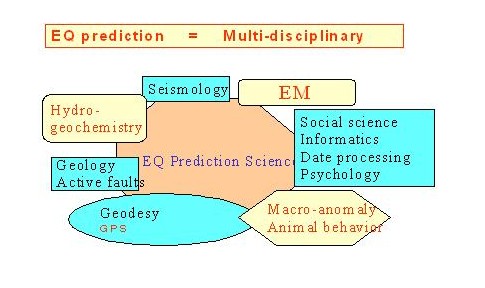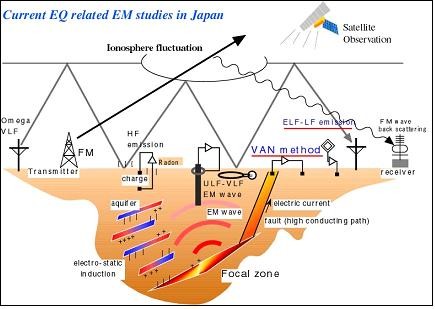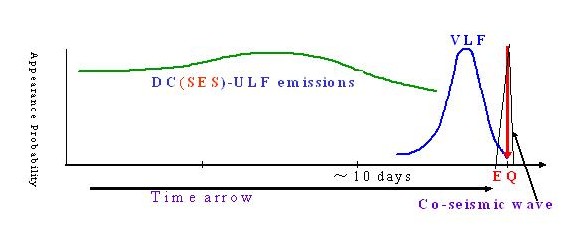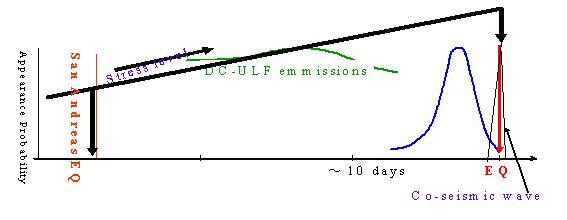Keywords - short-term earthquake prediction, precursors, seismology, Seismo-electromagnetics, VAN method, San Andreas Fault
I. INTRODUCTION
Mitigation of earthquake disaster is one of the most urgent societal needs in the modern world. Among seismic disasters, losses of human lives are most fatal, because other types of loss, however grave they may be, are recoverable in principle. Experiences amply show that majority of casualties at earthquakes is due to burial under fallen buildings[1]. Therefore, strengthening of buildings is most highly needed to save human lives. At the same time, earthquake prediction would also be very effective for the same purpose because if people knew about the destructive shaking well beforehand, loss of life may be made zero in principle. This is why, in the common sense of citizens, earthquake prediction means short-term prediction. Thus, anti-seismic engineering and short-term prediction are the two equally important measures for seismic disaster mitigation. The latter is of course one of the last frontiers in the earth science.
II. EARTHQUAKE PREDICTION
Thanks to modern seismology, we now know earthquakes are sudden displacements at faults and, thanks to plate tectonics, we also know the reason why tectonic stress is generated to cause fault motions. But, predicting, with useful precisions, when each fault motion actually takes place is still beyond our capability. Simply knowing the nature of phenomena and predicting their occurrences are different matters. This is why we need investigation specifically designed for the purpose.
Scientific short-term prediction can be made only when some reliable scientific precursor(s) are found. However, this obvious fact does not seem to be accepted by earthquake scientists, the seismologists. In fact, they should know well the needs of precursor(s), but they would not admit so because they also know that conventional seismology is not suitable for finding them. Normally, precursors are not earthquakes and not recorded by seismometers. So, they, consciously or unconsciously, tend to claim "Since we, experts of earthquakes, cannot find precursors, nobody else can. Therefore, precursor search should be abandoned and money and time should be spent for more basic seismology. Some day we may succeed in making short-term prediction." No body would deny the importance of basic research, but this attitude is illogical and unscientific.
Since precursors are likely non-seismological, the short-term earthquake prediction requires a new multi-disciplinary science and its basic research as illustrated in Fig. 1. In fact, when the National Earthquake Prediction Research Program was envisaged in Japan in early 1960s, such a multi-disciplinary approach was emphasized. Although scientific and technological level was nothing comparable to today's, they knew that multi-disciplinary study was the only way to go for short-term prediction. However, the initial program was designed to construct seismological and geodetic networks. Of course it was a necessary first step, but definitely insufficient for the prediction purpose. Moreover, once it started in this manner, network construction became a never ending enterprise. It even became almost the very goal of the whole program which became dictated by the exclusive "club" of seismologists. Funds and research positions were largely monopolized. Naturally, no short-term prediction has been ever made, not even a false one. Although non-seismological search for precursors, such as those of ground water level, radon emission and electromagnetic variations, were making some progress by a handful of poorly funded scientists, they were practically disregarded.

Fig. 1
The 1995 M7.2 Kobe earthquake was a big blow to the program. Although the program never claimed that such "small" earthquakes could be predicted, the program was widely subjected to criticism. Serious outside scientific reviews were made by those who had not actually been running the program. After deliberations, however, they came to the conclusion as cited above; namely precursors are too difficult to find, so that search for them, i. e., short-term prediction, should be abandoned and more seismic (broad band, high powered) and geodetic (GPS) networks must be installed for basic studies. After all, most of the review committee members were seismologists. Basic studies are always important, but they made two fundamental mistakes.
1) Precursor search has never been made by the program.In this way, they parried the criticism and saved the prediction program. They even succeeded in getting almost ever lasting funds which turned out to be much greater than before the Kobe disaster. The government had every reason to provide stronger support on earthquake science after the Kobe disaster. More importantly, the survived program does not bear responsibility for achieving short-term prediction. Naturally, by installing thousands of seismic and GPS stations, remarkable findings have been made in the years after the Kobe event. Details of ultra slow earthquakes[2], asperities at seismogenic zones[3], deep low frequency tremors associated with subduction[4] and stress concentration in Niigata-Kobe Tectonic Zone[5] are examples of such products. This has to be congratulated but, as to the short-term prediction purpose, even a small fraction of the national budget has not been defrayed for non-seismic/geodetic investigations. This situation must be changed. In fact, although the general public is not well informed about this situation, some concerns are arising among those who are in charge that the present paradise for seismology may not last too long.
2) Possibilities other than seismological / geodetic were not considered. "We cannot. Therefore, no body can." Basic study is also needed for precursor research.
III. PROBLEMS IN SEISMO-ELECTROMAGNETICS
Among various non-seismological/geodetic approaches, the present author is familiar with Seismo-electromagnetics. It deals with possible pre-seismic signatures in a wide range of frequency (DC-VHF). The relevant phenomena may be classified into the following two categories (Fig.2).
1. Emissions from focal zones, such as SES in VAN method [6,7]and ULF/VLF emissions[8,9].Although not shown in Fig. 2, there is a third category, which is detection of pre-seismic changes in the underground electrical structures. Although studies on the electrical structures have made considerable progress lately, there have been few convincing reports on their time changes so far. In this regard, EM ACROSS, an active continuous monitoring of electrical structures under development in Japan, is one of those which may shed new lights not before long[14].
2. Anomalous EM wave transmission in VLF-VHF ranges[8, 10,11] interpreted by LAI coupling hypothesis[12, 13].

Fig.2
During the last couple of decades, substantial progress has been accomplished in electro-magnetic short-term precursor research. We now have a conceptual view as shown in Fig. 3 for the appearance probability of signal emission based on rather well repeated observations.

Fig. 3
However, it is still far from general recognition. One can blame the biased views of outsiders, but part of this situation is certainly due to inadequateness on our side, namely our science has not been convincing enough.
a) We still lack in "home run" observations. Precursor observations are more or less isolated pieces. Simultaneous observation by multiple methods by multiple groups would help.
b) Many fundamental questions are unresolved. To name a few, the true mechanism of SES generation has not been demonstrated by lab. experiments, the transmission of signals beyond the "skin depth" distance in conductive earth is not explained, and the true mechanism of LAI coupling is far from clarified.
To be more specific, c) Why no truly co-seismic signals have ever been observed? Observed "co-seismic" signals are always "co-seismic wave"[8]. Why pre-seismic signals are not correlated with any other geophysical events? These questions often drive outside scientists to skepticism about any pre-seismic signals. “Signals should be much stronger at the time of earthquake when the stress change is by far the largest.” As to this point, it must be pointed out that pre-seismic stage is a slow stress increasing process while earthquake is a sudden stress releasing process. They are quite dissimilar processes and there is no compelling reason why same thing happens. Observations simply demand that the true signal generation mechanism must explain why pre-seismic signals are generated when the stress level reaches a critical point during the slow stress enhancement process without any discrete event such as micro-fracture. VAN's Pressure Stimulated Current hypothesis[6] satisfies these conditions but it still lacks in decisive experimental proof.
Finally, it might be mentioned that pre-seismic signals have been observed in Greece and Japan[8], but not at San Andreas Fault, California[15].This can be a basis of serious objection to SES. However, it may be pointed out that San Andreas Fault is a very weak fault[16] and it might be possible that earthquake takes place before the stress level reaches the critical value for SES generation as shown in Fig. 4. But this is a guess at this stage. It is also likely that their methodology has been inadequate in taking care of the selectivity which is well known in VAN's work[6,17].

Fig.4
IV CONCLUSION
Seismo-electromagnetics is one of the promising approaches to short-term earthquake prediction. But, it has not been fully recognized by the science community at large. It seems mainly due to the fact that this approach is foreign to conventional seismology. But it is also true this new science is still too incomplete to claim wide acceptance. Further efforts in making convincing observations and more rigorous theoretical basis are vitally important. International as well as inter-disciplinary cooperation must be encouraged.
REFERENCES
[1] S. Uyeda and K. Meguro, "Earthquake prediction, seismic hazard, and vulnerability", 349-358, in "The state of the Planet – Frontiers and Challenges in Geophysics", (Eds. R. S. J. Sparks and C. J. Hawkesworth), Geophys. Monogr. Series, Amer. Geophys. Un. and Intn. Un. Geodesy and Geophysics, 2004.
[2] I. Kawasaki, "Silent earthquakes occurring in a stable-unstable transition zone and implications for earthquake prediction", Earth Planet and Space, 56, 813-821, 2004.
[3] Yamanaka, Y. and M. Kikuchi, "Asperity map along the subduction zone in northeastern Japan inferred from regional seismic data", Jour. Geophys. Res., 109, B07307, doi:10,1029/2003JB002683, 2004
[4] K. Obara, "Nonvolcanic Deep Tremor Associated with Subduction in Southwest Japan", Science, 296, 1679-1681, May 31 2002.
[5] Y. Iio, T. Sagiya, and Y. Kobayashi, "Origin of the concentrated deformation zone in the Japanese Islands and stress accumulation process of intraplate earthquakes", Earth Planets Space, 56, 831-842, 2004.
[6] P. Varotsos, The Physics of Seismic Electric Signals, TerraPub, Tokyo 338 pp, 2005.
[7] K. Hattori, "ULF geomagnetic changes associated with large earthquakes", Terrestrial, Atmospheric and Oceanic Sciences, 15, No.3, 329-360, 2004
[8] S. Uyeda, T. Nagao and H. Tanaka, "A Report from the RIKEN International Frontier Research Project on Earthquakes (IFREQ)", Terrestrial, Atmospheric and Oceanic Sciences, 15, No.3, 269-310, 2004.
[9] M. Hayakawa, O. A. Molchanov, "Achievement of NASDA's Earthquake Remote Sensing Project", Terrestrial, Atmospheric and Oceanic Sciences, 15, No.3, 311-327, 2004.
[10] Y. Kushida and R. Kushida, "Possibility of earthquake forecast by radio observations in the VHF band", J. Atmosph. Electricity, 22,239-225, 2002.
[11] H. Fujiwara, M. Kamogawa, M. Ikeda, J.Y. Liu, H. Sakata, Y. I. Chen, H. Ofuruton, S. Muramatsu, Y. C. Chuo, Y. H. Ohtsuki, "Atmospheric anomalies observed during earthquake occurrences", Geophys. Res. Lett., 31, L17110, doi:10.029・2004GL019865, 2004.
[12] S. Pulinets and K. Boyarchuk, Ionospheric Precursors of Earthquakes, Springer, 316 pp., 2005.
[13] M. Kamogawa, "Preseismic lithosphere-atmosphere-ionosphere coupling", EOS, 87, No.40,417,434¸Oct. 3, 2006.
[14] Proceedings: 1st International Workshop Active Monitoring in the Solid Earth Geophysics (IWAM04), Mizunami, Japan, 2004.
[15] M. Johnston, Y. Sasai, G. Egbert, and R. Mueller, "Seismomagnetic effects from the long-awaited 28 September 2004 M 6.0 Parkfield earthquake", Bull. Seism. Soc. Am. 96, no.4B, S206-S220, 2006.
[16] J. Townend and M. Zoback, "Regional tectonic stress near the San Andreas fault in central and southern California", Geophys. Res. Lett., 31, L15S11, doi: 10.1029/2003GL018918, 2004.
[17] P. Varotsos and S. Uyeda, "Comment on Seismomagnetic Effects from the Long-Awaited 28 September 2004 M 6.0 Parkfield Earthquake by M.J.S. Johnston, Y. Sasai, G.D. Egbert, R.J. Mueller", submitted to Bull. Seism. Soc. Am. for publication.